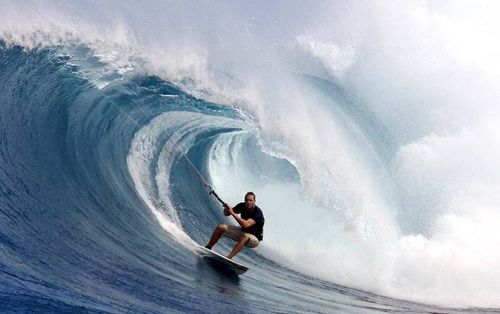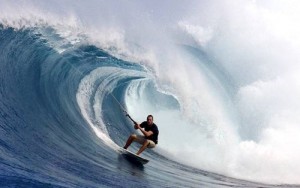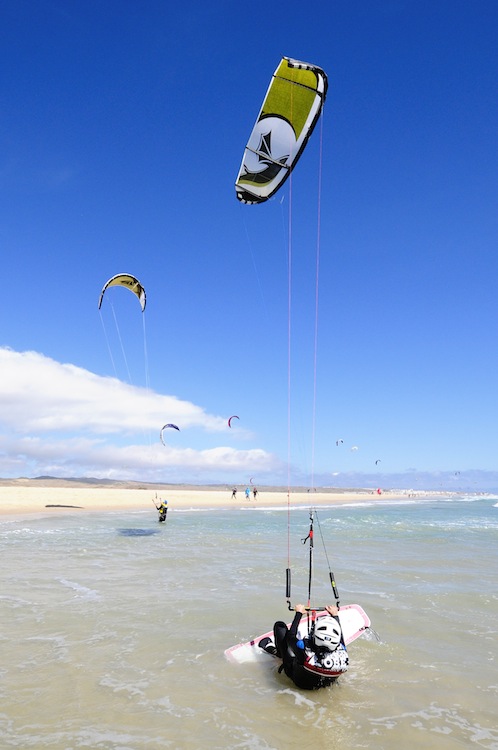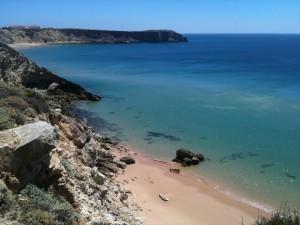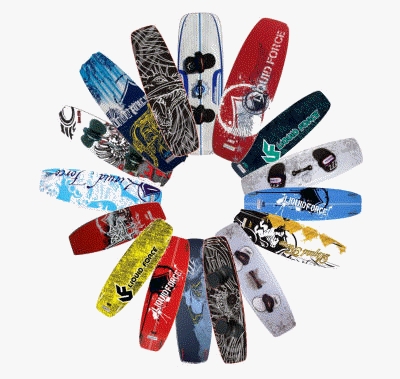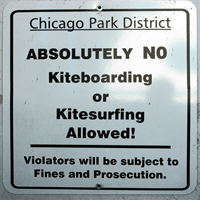
As a destination for your kitesurfing holidays, Portugal is definitely divided into 2 distinct areas each with its own conditions and things to offer. The South coast offers flatter water, lagoons and better conditions for beginners. During the summer this isn’t really suitable for kitesurfing in many areas due to the offshore winds and multitude of sunbathers. There are spots on the S coast where kitesurfing is possible in the summer. We found one in Cabanas de Tavira in the beautiful Ria Formosa, a natural reserve in the eastern Algarve where we found the school Eolis and its super friendly owner Sandra. This looked like a great spot to kitesurf…as long as you had a big kite, the beach was the emptiest we’d seen on the S coast and the ferry over the river to get to the beach just made the whole experience much more interesting.
The most famous spot on the S coast in the summer months is the lagoon at Alvor and rightly so. While we were there we scored some awesome days on this lagoon. Its a fair old walk to get to but is well worth it, huge, windy, empty and with sandbanks acting as wave breaks ensuring that you can find some really flat patches. On the day we were there there were maybe 10 other kiters on the water. This lagoon is shallow enough to be perfect to learn in and deep enough to practice all the moves you want without fear of landing on the sand…oh and the wind seems to blow stronger here than at any point up or down the coast. In the winter we we’re told that this coast is great with the wind blowing cross on, and pretty much every beach being accessible for kitesurfing…which gave us just one more excuse to go back!
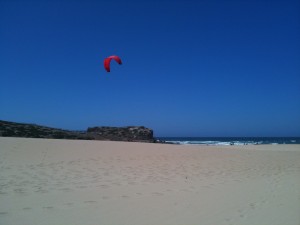
The West coast is a different beast altogether. The first thing that strikes you when you hit the West coast of Portugal is the scenery. Its dramatic to say the least. Huge cliffs dropping down into crystal clear blue ocean, with beautiful, golden sanded, coves nestled in between the shoulders of the cliff face. Perfect swell and white capping waves complete the scene. What also strikes you is the fact that there is almost no one else around. The entire coast seems forgotten. We were there in June and it felt more like November given the amount of people there were. Literally you could walk onto beaches that are km’s long and straight out of a post card and see only one or 2 other souls.
Picturesque it may be but those waves are mean. Even in June (the flat season!) we looked at many of the breaks and gulped. The waves are beautiful but they are powerful, with large rips and the rocky shoreline making this coastline all the more treacherous. Most spots here are definitely for experts only, and I can’t imagine what this coast is like in the winter when the real swell comes through. That said we did find some places that would be great for your kitesurfing holidays. Carrapateira is one such place, a huge open beach surrounded by cliffs but long enough to give you a good reach without coming to close to the cliffs. The waves here are truly world class, with line after line of swell rolling in relentlessly. If I had to describe this coast in one word the word I would choose is wild. Its almost as if it’s been forgotten about by the world, by tourism and certainly by kitesurfers.
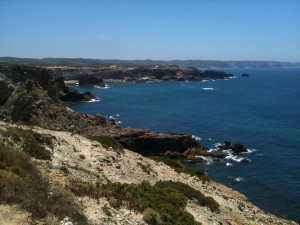
The really great thing about Portugal is that this massive range of conditions are so accessible. Start the day in Alvaro on the lagoon and fancy a bit of wave riding or surfing tin the afternoon, no problems all the beaches we visited are within 1 hours drive of you and Portugal’s road network is really good.
The south coast offers something else that the West coast has next to none of…nightlife. This is the Algarve and if partying all night and waking up to a full English breakfast is your thing then this is a great place for you. For the more tranquil is does manage to maintain an air of dignity that was lost on the Costa del Sol and many other English holiday resorts long ago. The tourism here seems less frantic and less inclined to cause chaos than in Fuengirola or Marbella. Despite the fact that I usually hate English style resort towns I actually found myself liking the Algarve. Lagos is a beautiful town, with colonial architecture and a laid back, stress free feel. There are plenty of smaller towns up and down the coast that provide the ability to get away from it all without the stress normally associated with a holiday resort..in June we managed to find parking every time.
The prices are cheap (apart from fuel) with a fish dinner costing around 7 €, and that’s not just 1 fish but 3!! Accommodation seems very reasonable too, we ended up paying about 50 € a night for a really nice self catered flat in the middle of Lagos. As a race the Portuguese seem to have developed a refined sophisticated air that you wouldn’t expect from the normally fiery Latino blood. They are generally very friendly but in a much more reserved way than you would find in Spain or Brazil for example. English is also the second language here (a fact we discovered of spending the first 2 days trying to speak Spanish!) so communication is generally easy, and people will genuinely take the time and be patient if they can’t understand, which makes communication fun, rather than a stress.
After just a few days spent in Portugal I fell in love with the place, both as a tourist and as a destination for future kitesurfing holidays. The whole country has a laid back feeling which is difficult not to become infected by. I would need to see it in winter and in the height of summer before I could truly pass judgement but that just gives me some perfect excuses to go back!
